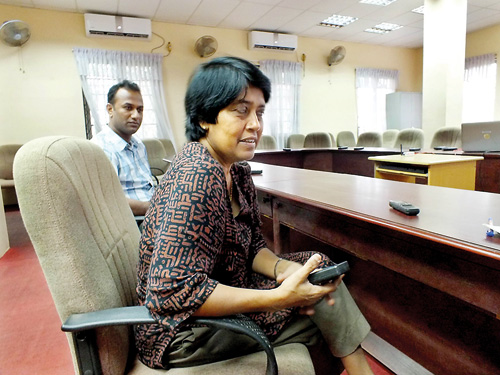New device to test student responses
Universities today are increasingly involved in broader projects inclined towards commercialisation based on their research and not confined to the precincts of these halls of intellectual learning.

Prof. Kanthi Yapa explains the project.
In this backdrop, the Department of Physics, University of Ruhuna launched an electronically based project ‘Student/Audience Response System’ (SRS) in 2015 and which was completed in 2018. For the success of the project, the National Science Foundation (NSF) under its Technology Grant Scheme awarded Rs. 1.2 million.
To obtain the details of the SRS a team consisting of NSF and the Business Times (BT) went to Ruhuna University, Matara, recently and met Prof. Kanthi Yapa, Department of Physics, Ruhuna University in the company of Sisila Abeywickrama, an expert on Electronics.
Prof. Yapa started demonstrating how the system works. Ms. Iresha Karunaratne, Scientific Officer, NSF who accompanied the team from Colombo said that the grant from NSF was awarded to overcome the difficulty of identifying student responses for regular quizzes given to the students at the end of a lecture session in a university where the number exceeds 100.
She said that the output of the project is homemade and low cost that could be used in varying environments and now that is being used by undergraduates. It can be used in classroom environments, in schools, universities and higher educational institutes or any other academic audience as well as any social/cultural/human resource management institutes covering a vast range of activities in fast, easy, user-friendly and cost-effective manner. Researchers intend to scale up the product and commercialise it.
The device is small – similar to the size of a mobile telephone. Prof. Yapa said that they could even include another small antenna inside the device to be stronger and then signals could reach a range of 75 metres.
They have made 150 of those devices as prototypes with the shortcomings to be overcome and the device upgraded before it is introduced to the market. She said: “We did this on a trial basis”. The project is undertaken by three individuals – Prof. Yapa, Sisila Abeywickrama and Prof. W.G.D. Dharmarama, Dean, Faculty of Science, Ruhuna University and handled by the Department of Physics.
She said that when she was on sabbatical leave in the US few years back she found these types of devices there. The one they have made is not identical and it is completely an innovation made to suit the local conditions. It can be used in any language through a PowerPoint presentation and as the screen of the device is too small it would be difficult for the next person to copy in an examination sitting.
The teacher operates the administrative tools. The number of devices used in the room – say 150 would appear in the large screen as red and when registered it becomes yellow and when the student starts operating it becomes green, she indicated.
If the teacher wants to have a new quiz or to change the existing quiz the teacher can do that. Step one is to load the quiz, the number of quizzes and the time allotted are indicated. The number of the device is printed on the back of it. The quiz appears on the large screen for the students to read and respond.
She indicated that the approximate cost of a device is Rs. 4,000 and said that when they made the 150 devices, the prices of electronic components were prohibitive, but now they have come down to less than half and if the devices are made now the cost could be reduced to that proportion.
The statistics appear immediately, automatically and the teacher can see how many students have answered the questions and whether the response is good or bad and it would even give a graph indicating the performance, she pointed out.
The device could be modified to suit various requirements and even make the screen bigger to be like an old mobile phone, where things can be typed, but if it is in the form of a smartphone, when it is used for examination purposes, the student can access the Internet and sometimes download notes, Prof. Yapa explained.
Though not surveyed, she said there is heavy potential for commercialisation, if they can tap the Education Department and the Examination Department, for instance and also other institutions can use it.
The NSF has been awarding ‘Technology Grants’ for several projects so far which have been mostly successful in commercialising. It also awards another grant in the form of ‘Start-ups’. Prof. Yapa indicated that as they have completed the Student Response System successfully, they are eligible to apply for the ‘Start-up Grant.’
She said that the Physics Department has launched several other projects and they are now handling an ambitious project on an automated telescope to study stars in the universe and astronomy on a large World Bank grant.


